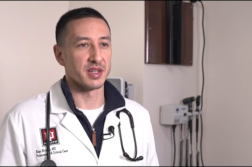NEW JERSEY (Ivanhoe Newswire) – According to the Centers for Disease Control and Prevention, COPD, or chronic obstructive pulmonary disease was the sixth leading cause of death in the U.S. in 2020. The condition limits airflow in and out of the lungs, making it difficult to breathe. Until recently, the primary treatment options were inhalers and oxygen. But now, there’s another alternative.
Seventy-three-year-old Frances Clark describes what it’s like to have COPD, or chronic obstructive pulmonary disease.
“I was hanging on to my soap dish trying to catch my breath in the shower,” she tells Ivanhoe.
The progressive condition limits airflow in and out of the lungs, making it hard to breathe. Diagnosed more than 25 years ago, the former hairdresser and decades-long smoker says her disease progressed to the point where she was forced to go on oxygen, and making simple daily tasks a lot more difficult.
Clark adds, “Carrying a laundry basket – everything was a challenge.”
But things have gotten a lot better for Clark. This after she underwent a minimally-invasive procedure last April in which these zephyr endobronchial valves were implanted into the left side of her lung by Interventional pulmonologist at Hackensack University Medical Center in New Jersey, Nadeem Ali, MD. The tiny, one-way valves allow the healthier portions of the lung to work more efficiently.
“Lung volume reduction surgery procedure is done via a small camera, place three to five small valves,” Dr. Ali explains.
It’s designed for patients with significant to moderate COPD but individuals are required to have quit smoking at least three months prior to the procedure.
Dr. Ali adds, “After the volume reduction procedure is performed, we want you to exercise, and after you get home.”
In Clark’s case, it’s been life-changing, not only making household tasks much easier, but allowing her to travel and spend time with family. Potential candidates for this procedure will undergo testing to determine their eligibility. For more information visit lungvalves.com.
Contributors to this news report include: Sherry Karabin, Producer; Tim Stollery, Videographer; Matt Goldschmidt, Editor.
To receive a free weekly e-mail on medical breakthroughs from Ivanhoe, sign up at: http://www.ivanhoe.com/ftk
MEDICAL BREAKTHROUGHS
RESEARCH SUMMARY
TITLE: WHY SOME COPD PATIENTS ARE TAKING A DEEP BREATH
REPORT: MB #5350
BACKGROUND: Chronic Obstructive Pulmonary Disease (COPD) is a progressive respiratory condition characterized by persistent airflow limitation. It encompasses several chronic lung diseases, including emphysema, chronic bronchitis, and refractory (non-reversible) asthma. COPD is typically caused by long-term exposure to irritating gases or particulate matter, most commonly from cigarette smoke. However, other factors such as exposure to indoor and outdoor air pollutants, occupational dust and chemicals, and genetic predisposition can also contribute to its development. Among the various treatment modalities available, bronchoscopic lung volume reduction (BLVR) has emerged as a promising option for patients with advanced COPD. BLVR aims to reduce hyperinflation and improve lung function by targeting the most diseased areas of the lungs. During a BLVR procedure, a thin, flexible tube with a camera and tools is inserted into the airways through the mouth or nose. Once inside the lungs, the physician can perform different techniques to reduce lung volume.
https://www.templehealth.org/services/treatments/bronchoscopic-lung-volume-reduction
DIAGNOSING: Diagnosing Chronic Obstructive Pulmonary Disease (COPD) involves a combination of clinical assessment, medical history, and diagnostic tests. Given its progressive nature and varied presentation, diagnosing COPD accurately is crucial for initiating appropriate treatment and improving patient outcomes. Gathering a detailed medical history is the initial step in diagnosing COPD. Inquiring about symptoms such as chronic cough, shortness of breath, wheezing, and sputum production as well as Identifying risk factors such as smoking history, exposure to environmental pollutants, and genetic predispositions are key components in collecting a detailed medical history. A thorough physical examination can provide valuable clues to the presence and severity of COPD and key findings may include abnormal lung sounds, assessment of respiratory efforts, assessment of cyanosis, and assessment of pulmonary function.
(Source: https://www.who.int/news-room/fact-sheets/detail/chronic-obstructive-pulmonary-disease-(copd)
NEW TECHNOLOGY: The RESP Biosensor is an FDA-cleared and wearable device created by Strados Labs. It offers a new approach to COPD management by monitoring and capturing lung sounds continuously mirroring the way a stelescope works. This allows medical professionals to objectively monitor changes such as wheezing and coughing which are early signs of COPD activities.
FOR MORE INFORMATION ON THIS REPORT, PLEASE CONTACT:
Nadeem Ali
If this story or any other Ivanhoe story has impacted your life or prompted you or someone you know to seek or change treatments, please let us know by contacting Marjorie Bekaert Thomas at mthomas@ivanhoe.com




